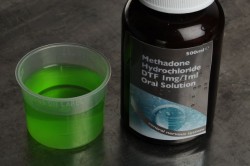How Inpatient Methadone Treatment Works
Methadone is one of the most common replacement drugs for opioids and opiates. Methadone is a weak opiate so it replaces the heroin or prescription painkiller that a person is addicted to. Some people say that because methadone is addictive, methadone treatment is just trading one addiction for another. According to the National Institute on Drug Abuse, methadone replacement therapy when done correctly is not a dangerous addiction like heroin or other opiates. It causes an overall reduction in the drug cravings and helps people stop using opiates completely. In order to understand how inpatient methadone treatment works it is important to know what methadone treatment is, the types of methadone treatment, how inpatient detox works, and why it works.
What is Methadone Treatment

Methadone treats opiate addiction.
Methadone treatment or methadone replacement treatment is a therapy designed to help someone get off an opiate opioid drug. Common opiate and opioids are:
- Heroin,
- Opium,
- Morphine,
- Oxycodone,
- Oxycotin, and
- All other opioid and opiate deriviatives.
Methadone is known to work in a variety of different ways. A few of the things methadone does individually and to the population of drug users are it:
- reduces the risk of suicide,
- reduces the risk of lethal overdose,
- reduces needle sharing,
- reduces commercial sex trafficking,
- reduces HIV rates,
- increase overall social health and wellbeing including productivity,
- reduces criminal activities associated with drug use,
- improves overall health, and
- is extremely cost effective.
These are all benefits of using methadone treatment in general and inpatient methadone detox and rehab as a whole.
When someone is on an opiate, the drug binds to the opioid receptors and causes dopamine to flood the brain. Dopamine makes a person feel euphoric, happy, content, sleepy, and generally good. When a person is on an opiate for a very long time it causes damage to the receptors. After so much dopamine floods the brain, a person becomes incapable of feeling pleasure normally. When the person stops taking the opiate, the receptors do not function properly. This causes a person to go into withdrawal. The withdrawal symptoms range from nausea to severe cramping and depression. When someone takes methadone, it blocks these receptors and mildly excites dopamine production. This is just enough to stop the withdrawal but not cause the dopamine flood.
Inpatient Treatment using Methadone
Inpatient methadone treatment starts with detoxing from the opiate. This causes large amounts havoc with the body under normal circumstances. Methadone treatment makes this less unpleasant. It stops the withdrawal symptoms. This allows the patient to detox from the opiate without going through the unpleasant side effect. Without methadone a patient experiences:
- extreme hot and cold sensations,
- chills and fever,
- runny nose and watery eyes,
- nausea and vomiting,
- diarrhea,
- anxiety,
- cramping and severe pain,
- depression, and
- agitation.
Methadone stops these withdrawal symptoms and turns the addiction around. The patient can then concentrate on changing the illness or circumstances that caused the original addiction.
Most people with chronic pain start their addiction treating the pain. Unfortunately, once they come off the opiates, the pain returns. It is up to the inpatient staff to help the patient overcome their pain as well as the addiction. Doctors provide other medications as well as the methadone. The methadone itself is a powerful painkiller.
Others become addicted to painkillers or heroin as a form of self-medication for a mental or psychiatric illness. In this case, methadone helps both the withdrawal and the illness until a proper medication is found. Most people who are in this predicament need treatment. With inpatient conditions, the illness is identified and treated before the patient is released.
Another reason why people turn to heroin and other opiates is stress. Inpatient treatment removes the person from the stressful situation and helps to teach them coping mechanisms to deal with the stress without drugs. Methadone helps to clear the withdrawal and allows the patient to concentrate on learning new techniques.
Why Inpatient Methadone Treatment Works
Inpatient methadone treatment works mainly because it stops the issues with withdrawal symptoms. Many people do not seek treatment for opiate addiction because of the seriousness and discomfort of the withdrawal symptoms. Methadone prevents those symptoms from becoming an issue. Without the symptoms of withdrawal, a patient can:
- take control and learn to deal with the cravings for the opiate,
- Identify the causes of the addiction,
- Get to work on the actual problem rather than go through the withdrawal,
- Speed up the timeline withdrawal takes,
- Ease chronic pain while a more suitable option is found,
- Learn coping techniques, and
- Reduce the fear associated with going through the withdrawal.
Although it seems that not having to deal with the symptoms of opiate withdrawal is a minor thing. It is not. Anyone who has gone through it will tell you that all of the symptoms are severe and that although it won’t kill you might wish it would. The withdrawal is part of what makes heroin and other opiates so difficult to get away from.
According to the University of Delaware, approximately 2.4 million people use heroin and other opiates on a regular basis. Any treatment including methadone treatment that helps a person get away from this dangerous drug is an important treatment option. Most people who have difficulty quitting opiates try multiple times. Inpatient methadone treatment has an extremely high rate of success. This success is made possible by easing the withdrawal symptoms and allowing you to focus on recovery.
